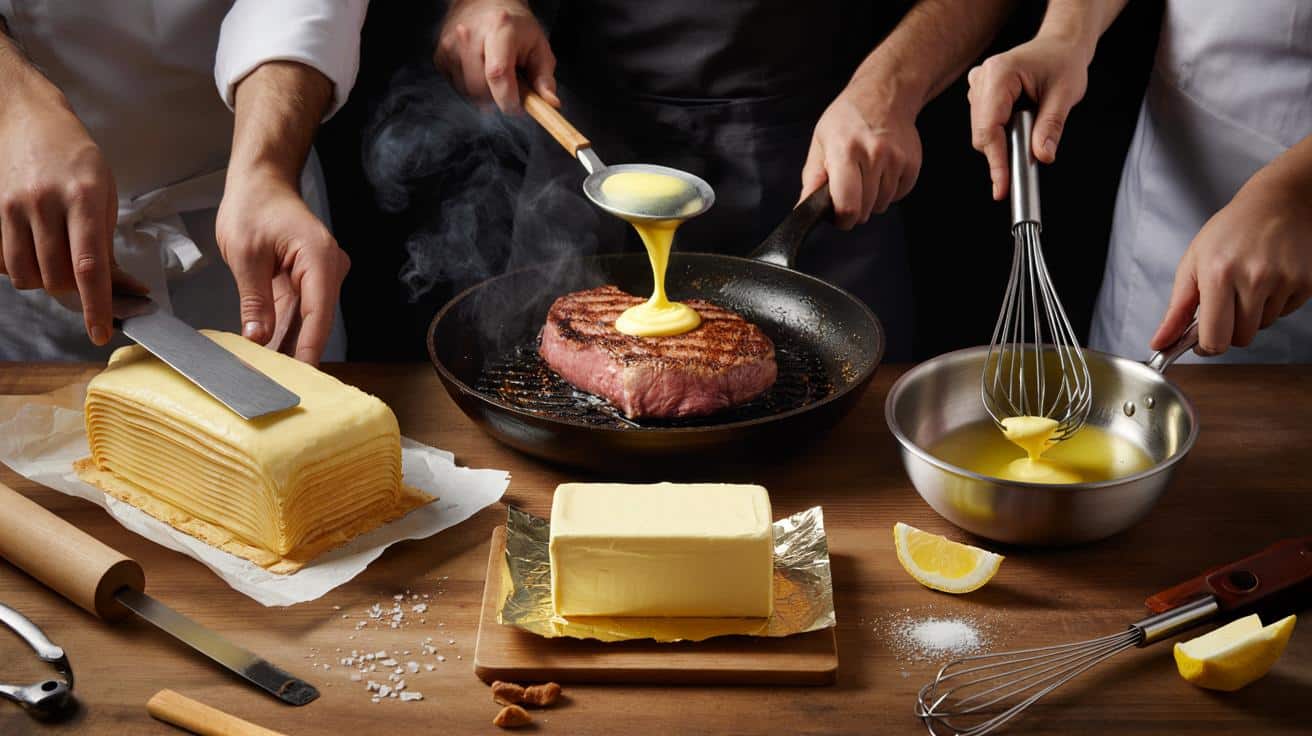Home cooks swear by salted sticks, bakers hoard blocks wrapped in gold foil, and chefs seem frustratingly serene about it all. We wanted one practical answer.
At 7 a.m. in a London bakery, the walk-in hums and you can taste the cold in the air. A pastry chef palms a block of butter, knocks it on the bench, and slides it into a sheet of dough like a letter into a coat pocket. Across town, a breakfast line cook drops a knob into a hot pan and everything goes quiet for a second — that held breath before sizzle. I asked four chefs the same blunt question while coffee cooled on the pass: what’s the best type of butter, full stop? They didn’t hedge, they didn’t phone a friend. They all picked the same one. A small shock.
The butter every chef named
All four chefs — a pastry lead in Shoreditch, a grill chef in Manchester, a neighbourhood bistro head in Brighton, and a private chef who lives out of a suitcase — chose the same thing: unsalted cultured butter with at least 82% butterfat. Not just “posh butter.” Cultured. Unsalted. High fat. They described a clean, lactic tang, a springy texture at room temperature, and fewer watery pops in the pan. **They said it behaves like a well-trained dog: eager, responsive, and never surprising you for the wrong reasons.**
Brighton bistro chef Lena told me she made hollandaise with standard supermarket butter for years and thought the tricky bit was her technique. Then she switched to cultured and the sauce stopped splitting on big brunch services. The pastry chef, Callum, said croissants gained a 10% taller lift in his tests when he used 84% butterfat, and the lamination felt calmer under the rolling pin. We’ve all had that moment when toast tastes oddly wet — that’s water, not flavour. Cultured butter trims that away and leaves you with richness you can actually taste.
If you’re wondering why cultured wins, think fermentation and fat percentage. Cultured butter starts with live bacterial cultures added to cream, which produce tiny amounts of acid and aromatic compounds as they feast. That gentle tang isn’t sour; it’s complexity. The higher butterfat means less water and more milk solids, so you get better browning, a rounder mouthfeel, and sauces that emulsify like a dream. In baking, less water means less steam at the wrong time, so laminated doughs stay tidy and biscuits don’t bake up patchy. The logic holds across both pastry and the pan.
How to choose and use cultured butter like a pro
Start with the label: look for “cultured” or “fermented,” “unsalted,” and a butterfat of 82% or higher. If the pack shows 84–85%, you’re in business for baking and finishing. For everyday cooking, buy 250–500 g blocks and portion them. Keep one block at room temp between 16–18°C for spreading; refrigerate the rest. For searing, temper a knob for 5 minutes so it hits the pan supple, not rock-hard. Salt at the end, not the start — cultured butter’s character shines when you finish with flaky salt.
There’s a trick for browning without burning. Use half cultured butter and half neutral oil for steaks or mushrooms; the oil stretches the browning window. For beurre noisette, melt gently, then push a little past the foam until the milk solids go hazelnut brown and the kitchen smells like toast and fudge. Let’s be honest: nobody does that every day. If you’re making a quick weeknight sauce, swirl in cold cubes off the heat and let the emulsion form without pressure. Small moves, big payoff.
Common pitfalls are sneaky. Salting early can mask the cultured notes. Using salted versions in baking will shift hydration and dull lamination. And microwaving to soften? The texture turns patchy. If you need soft butter for cake, grate it on the large side of a box grater and let it sit 10 minutes. I’ve watched chefs do this in the weeds and it saves both the batter and the mood.
“Cultured butter gives you forgiveness,” said Callum. “It’s not magic, it’s margin.”
- Buy: unsalted, cultured, 82–85% butterfat.
- Use: temper for the pan; keep a block at 16–18°C for spreading.
- Finish: add salt at the end to let the butter’s flavour breathe.
Why cultured butter tastes bigger — and where it shines
There’s science and there’s feel. Culturing creates diacetyl and other flavour compounds that read as butterscotch, yoghurt, and warm toast. The higher fat cushions those notes and carries aroma further, so a tiny knob seasons a whole pan of greens. On the grill station, Marcus finishes ribeye with a spoon of browned cultured butter and a squeeze of lemon: the meat tastes deeper, not just fattier. In pastry, the low water content means lamination stays well-defined and the crumb comes out open, not greasy. **This isn’t luxury for luxury’s sake; it’s butter that actually works harder.** You taste it in scrambled eggs and in beurre blanc alike.
If you cook for kids, cultured butter can quietly lift veg and pasta without chasing salt. If you bake once a month, it gives you croissants with layers you can count. If you meal-prep, it keeps sauces stable through reheating. **It’s the same butter, just a smarter tool.** The four chefs didn’t pitch brands; they pitched a category and a set of habits that make Tuesday dinner feel sorted.
Now step back. The love for cultured butter says something about where taste is heading: less sugar, more nuance; less brute force, more balance. You can use one block to do breakfast eggs, a pan sauce for fish, and a tray of biscuits, and it will behave, taste alive, and make your kitchen smell like the reason you started cooking in the first place. Phone down, toast up. That little tang brings the room together.
| Point clé | Détail | Intérêt pour le lecteur |
|---|---|---|
| Best type of butter | Unsalted cultured butter, 82–85% fat | One product that improves both cooking and baking |
| Why it wins | Lower water, gentle tang, better emulsions and browning | Fewer sauce splits, richer flavour with less effort |
| How to use it | Temper for the pan, finish with salt, half-butter half-oil for searing | Actionable steps for tastier, more reliable results |
FAQ :
- What exactly is cultured butter?Butter made from cream that’s been fermented with live cultures before churning, giving a subtle tang and deeper aroma.
- Why unsalted rather than salted?Unsalted lets you control seasoning and works better for baking and emulsions; you can add salt later for snap.
- Does cultured butter have a higher smoke point?Not really. The higher milk solids brown faster. For high heat, mix with oil or use clarified butter for the sear and finish with cultured.
- Can I bake with it 1:1?Yes in most recipes. For delicate pastries, start with the same weight and note that the dough may handle cleaner due to lower water.
- Is it worth the price?For anything you actually taste — sauces, laminated doughs, finishing — yes. For deep-frying or a roux, use standard and save the good stuff for the last touch.








